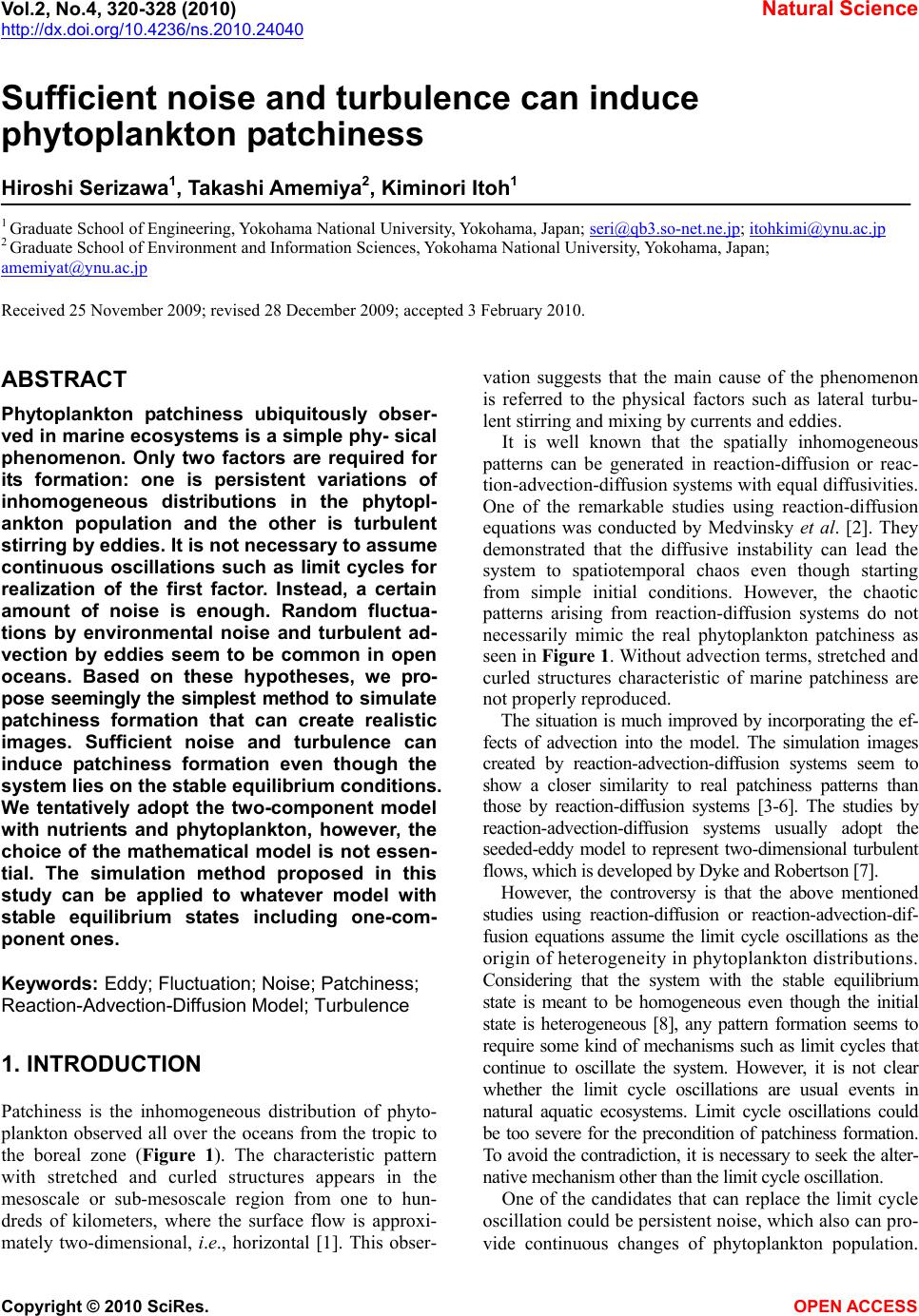 Vol.2, No.4, 320-328 (2010) Natural Science http://dx.doi.org/10.4236/ns.2010.24040 Copyright © 2010 SciRes. OPEN ACCESS Sufficient noise and turbulence can induce phytoplankton patchiness Hiroshi Serizawa1, Takashi Amemiya2, Kiminori Itoh1 1 Graduate School of Engineering, Yokohama National University, Yokohama, Japan; seri@qb3.so-net.ne.jp; itohkimi@ynu.ac.jp 2 Graduate School of Environment and Information Sciences, Yokohama National University, Yokohama, Japan; amemiyat@ynu.ac.jp Received 25 November 2009; revised 28 December 2009; accepted 3 February 2010. ABSTRACT Phytoplankton patchiness ubiquitously obser- ved in marine ecosystems is a simple phy- sical phenomenon. Only two factors are required for its formation: one is persistent variations of inhomogeneous distributions in the phytopl- ankton population and the other is turbulent stirring by eddies. It is not necessary to assume continuous oscillations such as limit cycles for realization of the first factor. Instead, a certain amount of noise is enough. Random fluctua- tions by environmental noise and turbulent ad- vection by eddies seem to be common in open oceans. Based on these hypotheses, we pro- pose seemingly the simplest method to simulate patchiness formation that can create realistic images. Sufficient noise and turbulence can induce patchiness formation even though the system lies on the stable equilibrium conditions. We tentatively adopt the two-component model with nutrients and phytoplankton, however, the choice of the mathematical model is not essen- tial. The simulation method proposed in this study can be applied to whatever model with stable equilibrium states including one-com- ponent ones. Keywords: Eddy; Fluctuation; Noise; Patchiness; Reaction-Advection-Diffusion Model; Turbulence 1. INTRODUCTION Patchiness is the inhomogeneous distribution of phyto- plankton observed all over the oceans from the tropic to the boreal zone (Figure 1). The characteristic pattern with stretched and curled structures appears in the mesoscale or sub-mesoscale region from one to hun- dreds of kilometers, where the surface flow is approxi- mately two-dimensional, i.e., horizontal [1]. This obser- vation suggests that the main cause of the phenomenon is referred to the physical factors such as lateral turbu- lent stirring and mixing by currents and eddies. It is well known that the spatially inhomogeneous patterns can be generated in reaction-diffusion or reac- tion-advection-diffusion systems with equal diffusivities. One of the remarkable studies using reaction-diffusion equations was conducted by Medvinsky et al. [2]. They demonstrated that the diffusive instability can lead the system to spatiotemporal chaos even though starting from simple initial conditions. However, the chaotic patterns arising from reaction-diffusion systems do not necessarily mimic the real phytoplankton patchiness as seen in Figure 1. Without advection terms, stretched and curled structures characteristic of marine patchiness are not properly reproduced. The situation is much improved by incorporating the ef- fects of advection into the model. The simulation images created by reaction-advection-diffusion systems seem to show a closer similarity to real patchiness patterns than those by reaction-diffusion systems [3-6]. The studies by reaction-advection-diffusion systems usually adopt the seeded-eddy model to represent two-dimensional turbulent flows, which is developed by Dyke and Robertson [7]. However, the controversy is that the above mentioned studies using reaction-diffusion or reaction-advection-dif- fusion equations assume the limit cycle oscillations as the origin of heterogeneity in phytoplankton distributions. Considering that the system with the stable equilibrium state is meant to be homogeneous even though the initial state is heterogeneous [8], any pattern formation seems to require some kind of mechanisms such as limit cycles that continue to oscillate the system. However, it is not clear whether the limit cycle oscillations are usual events in natural aquatic ecosystems. Limit cycle oscillations could be too severe for the precondition of patchiness formation. To avoid the contradiction, it is necessary to seek the alter- native mechanism other than the limit cycle oscillation. One of the candidates that can replace the limit cycle oscillation could be persistent noise, which also can pro- vide continuous changes of phytoplankton population. 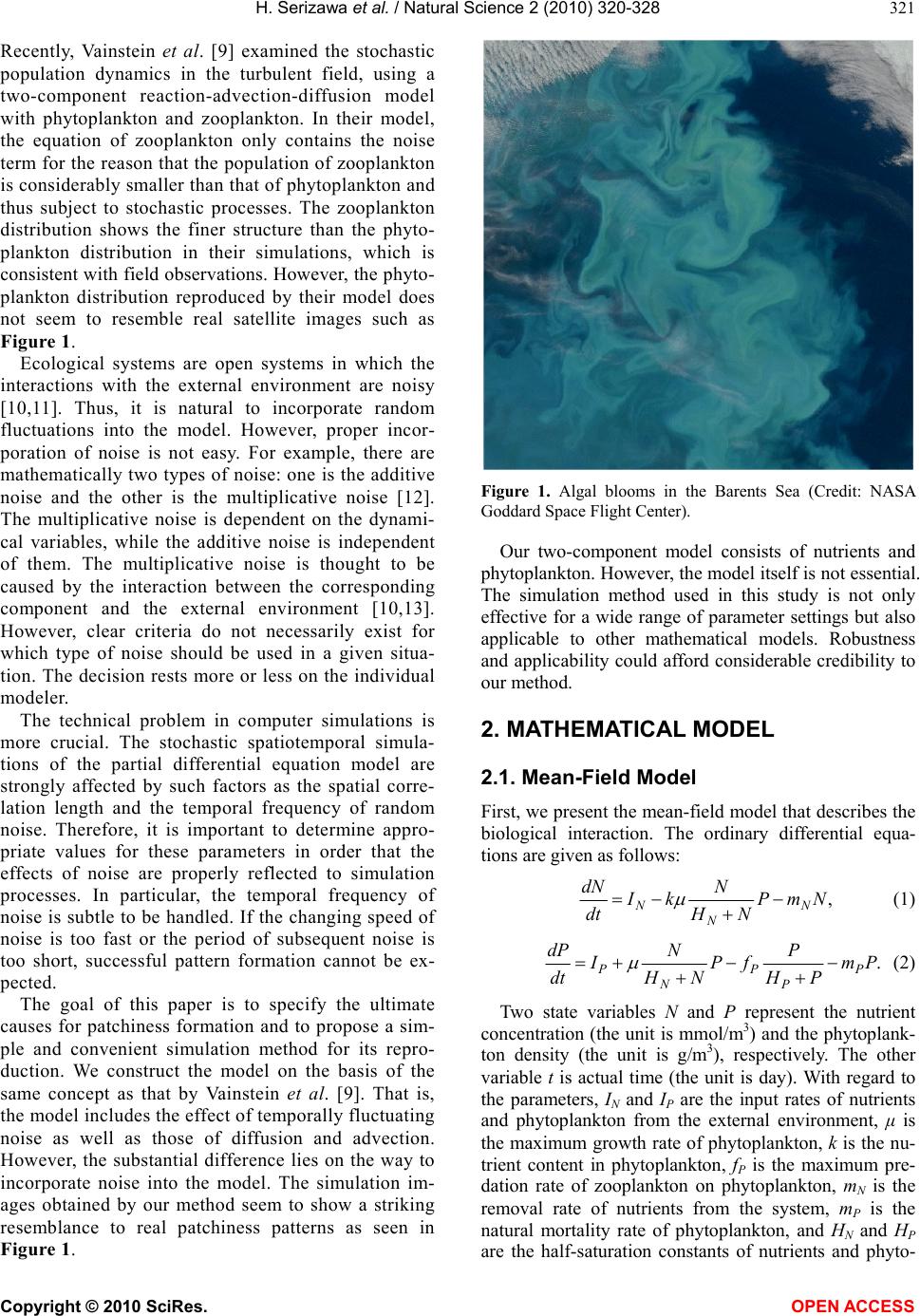 H. Serizawa et al. / Natural Science 2 (2010) 320-328 Copyright © 2010 SciRes. OPEN ACCESS 321 Recently, Vainstein et al. [9] examined the stochastic population dynamics in the turbulent field, using a two-component reaction-advection-diffusion model with phytoplankton and zooplankton. In their model, the equation of zooplankton only contains the noise term for the reason that the population of zooplankton is considerably smaller than that of phytoplankton and thus subject to stochastic processes. The zooplankton distribution shows the finer structure than the phyto- plankton distribution in their simulations, which is consistent with field observations. However, the phyto- plankton distribution reproduced by their model does not seem to resemble real satellite images such as Figure 1. Ecological systems are open systems in which the interactions with the external environment are noisy [10,11]. Thus, it is natural to incorporate random fluctuations into the model. However, proper incor- poration of noise is not easy. For example, there are mathematically two types of noise: one is the additive noise and the other is the multiplicative noise [12]. The multiplicative noise is dependent on the dynami- cal variables, while the additive noise is independent of them. The multiplicative noise is thought to be caused by the interaction between the corresponding component and the external environment [10,13]. However, clear criteria do not necessarily exist for which type of noise should be used in a given situa- tion. The decision rests more or less on the individual modeler. The technical problem in computer simulations is more crucial. The stochastic spatiotemporal simula- tions of the partial differential equation model are strongly affected by such factors as the spatial corre- lation length and the temporal frequency of random noise. Therefore, it is important to determine appro- priate values for these parameters in order that the effects of noise are properly reflected to simulation processes. In particular, the temporal frequency of noise is subtle to be handled. If the changing speed of noise is too fast or the period of subsequent noise is too short, successful pattern formation cannot be ex- pected. The goal of this paper is to specify the ultimate causes for patchiness formation and to propose a sim- ple and convenient simulation method for its repro- duction. We construct the model on the basis of the same concept as that by Vainstein et al. [9]. That is, the model includes the effect of temporally fluctuating noise as well as those of diffusion and advection. However, the substantial difference lies on the way to incorporate noise into the model. The simulation im- ages obtained by our method seem to show a striking resemblance to real patchiness patterns as seen in Figure 1. Figure 1. Algal blooms in the Barents Sea (Credit: NASA Goddard Space Flight Center). Our two-component model consists of nutrients and phytoplankton. However, the model itself is not essential. The simulation method used in this study is not only effective for a wide range of parameter settings but also applicable to other mathematical models. Robustness and applicability could afford considerable credibility to our method. 2. MATHEMATICAL MODEL 2.1. Mean-Field Model First, we present the mean-field model that describes the biological interaction. The ordinary differential equa- tions are given as follows: ,NmP NH N kI dt dN N N N (1) .Pm PH P fP NH N I dt dP P P P N P (2) Two state variables N and P represent the nutrient concentration (the unit is mmol/m3) and the phytoplank- ton density (the unit is g/m3), respectively. The other variable t is actual time (the unit is day). With regard to the parameters, IN and IP are the input rates of nutrients and phytoplankton from the external environment, μ is the maximum growth rate of phytoplankton, k is the nu- trient content in phytoplankton, fP is the maximum pre- dation rate of zooplankton on phytoplankton, mN is the removal rate of nutrients from the system, mP is the natural mortality rate of phytoplankton, and HN and HP are the half-saturation constants of nutrients and phyto- 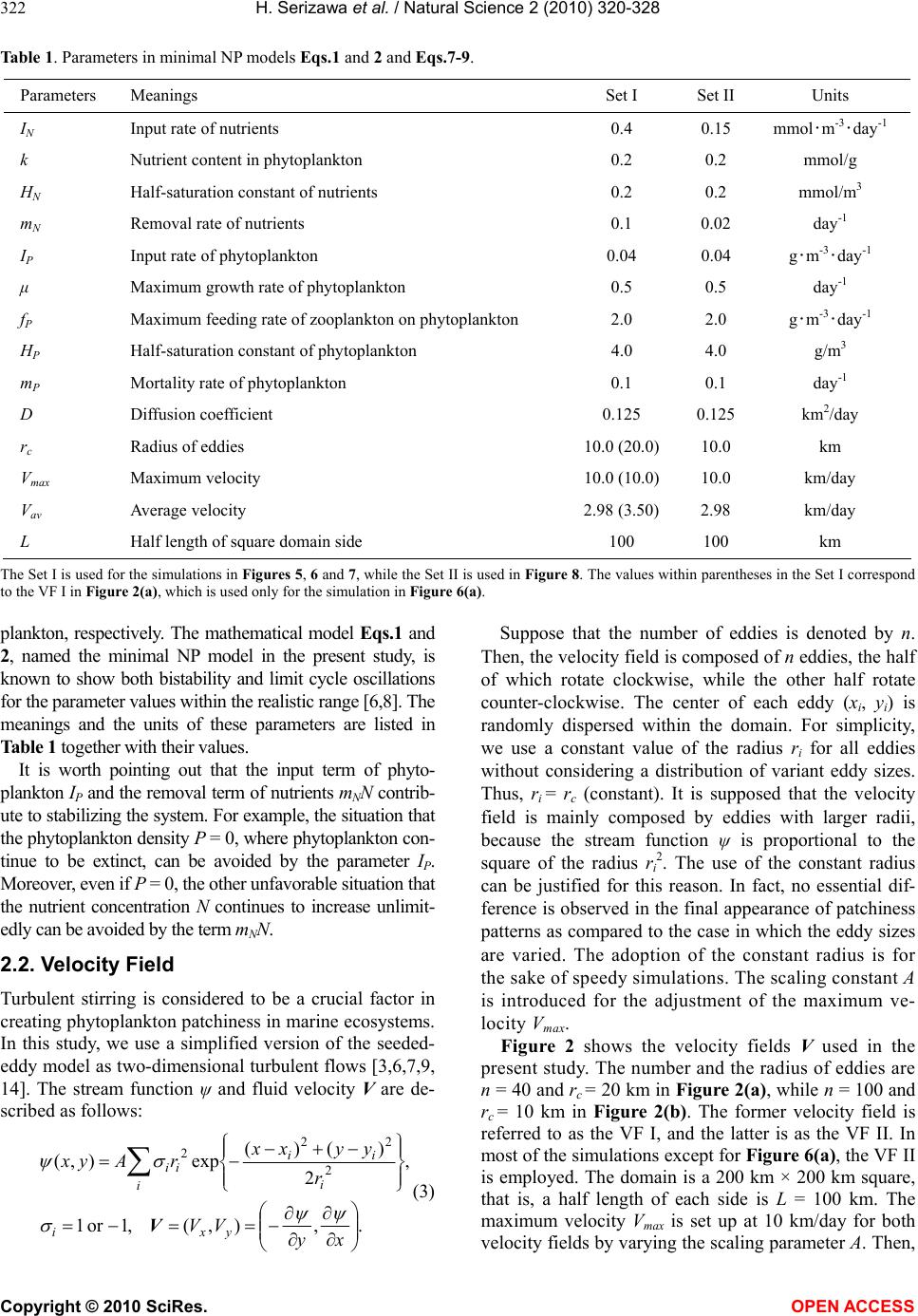 H. Serizawa et al. / Natural Science 2 (2010) 320-328 Copyright © 2010 SciRes. OPEN ACCESS 322 Table 1. Parameters in minimal NP models Eqs.1 and 2 and Eqs.7-9. Parameters Meanings Set I Set II Units IN Input rate of nutrients 0.4 0.15 mmol・m-3・day-1 k Nutrient content in phytoplankton 0.2 0.2 mmol/g HN Half-saturation constant of nutrients 0.2 0.2 mmol/m3 mN Removal rate of nutrients 0.1 0.02 day-1 IP Input rate of phytoplankton 0.04 0.04 g・m-3・day-1 μ Maximum growth rate of phytoplankton 0.5 0.5 day-1 fP Maximum feeding rate of zooplankton on phytoplankton 2.0 2.0 g・m-3・day-1 HP Half-saturation constant of phytoplankton 4.0 4.0 g/m3 mP Mortality rate of phytoplankton 0.1 0.1 day-1 D Diffusion coefficient 0.125 0.125 km2/day rc Radius of eddies 10.0 (20.0) 10.0 km Vmax Maximum velocity 10.0 (10.0) 10.0 km/day Vav Average velocity 2.98 (3.50) 2.98 km/day L Half length of square domain side 100 100 km The Set I is used for the simulations in Figures 5, 6 and 7, while the Set II is used in Figure 8. The values within parentheses in the Set I correspond to the VF I in Figure 2(a), which is used only for the simulation in Figure 6(a). plankton, respectively. The mathematical model Eqs.1 and 2, named the minimal NP model in the present study, is known to show both bistability and limit cycle oscillations for the parameter values within the realistic range [6,8]. The meanings and the units of these parameters are listed in Table 1 together with their values. It is worth pointing out that the input term of phyto- plankton IP and the removal term of nutrients mNN contrib- ute to stabilizing the system. For example, the situation that the phytoplankton density P = 0, where phytoplankton con- tinue to be extinct, can be avoided by the parameter IP. Moreover, even if P = 0, the other unfavorable situation that the nutrient concentration N continues to increase unlimit- edly can be avoided by the term mNN. 2.2. Velocity Field Turbulent stirring is considered to be a crucial factor in creating phytoplankton patchiness in marine ecosystems. In this study, we use a simplified version of the seeded- eddy model as two-dimensional turbulent flows [3,6,7,9, 14]. The stream function ψ and fluid velocity V are de- scribed as follows: .,),(,1or1 , 2 )()( exp),( 2 22 2 xy VV r yyxx rAyx yxi ii ii ii V (3) Suppose that the number of eddies is denoted by n. Then, the velocity field is composed of n eddies, the half of which rotate clockwise, while the other half rotate counter-clockwise. The center of each eddy (xi, yi) is randomly dispersed within the domain. For simplicity, we use a constant value of the radius ri for all eddies without considering a distribution of variant eddy sizes. Thus, ri = rc (constant). It is supposed that the velocity field is mainly composed by eddies with larger radii, because the stream function ψ is proportional to the square of the radius ri 2. The use of the constant radius can be justified for this reason. In fact, no essential dif- ference is observed in the final appearance of patchiness patterns as compared to the case in which the eddy sizes are varied. The adoption of the constant radius is for the sake of speedy simulations. The scaling constant A is introduced for the adjustment of the maximum ve- locity Vmax. Figure 2 shows the velocity fields V used in the present study. The number and the radius of eddies are n = 40 and rc = 20 km in Figure 2(a), while n = 100 and rc = 10 km in Figure 2(b). The former velocity field is referred to as the VF I, and the latter is as the VF II. In most of the simulations except for Figure 6(a), the VF II is employed. The domain is a 200 km × 200 km square, that is, a half length of each side is L = 100 km. The maximum velocity Vmax is set up at 10 km/day for both velocity fields by varying the scaling parameter A. Then, 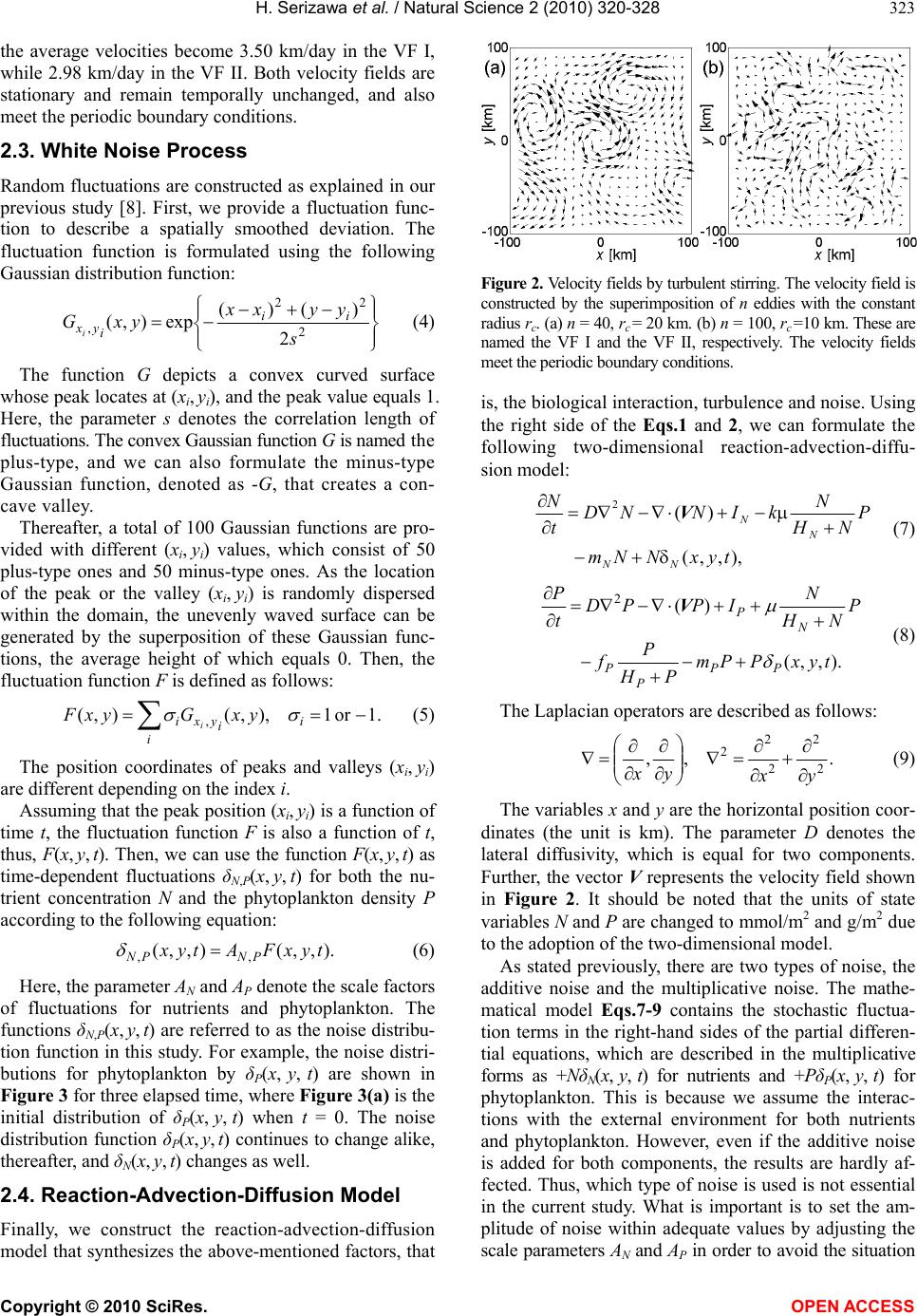 H. Serizawa et al. / Natural Science 2 (2010) 320-328 Copyright © 2010 SciRes. OPEN ACCESS 323 the average velocities become 3.50 km/day in the VF I, while 2.98 km/day in the VF II. Both velocity fields are stationary and remain temporally unchanged, and also meet the periodic boundary conditions. 2.3. White Noise Process Random fluctuations are constructed as explained in our previous study [8]. First, we provide a fluctuation func- tion to describe a spatially smoothed deviation. The fluctuation function is formulated using the following Gaussian distribution function: 2 22 ,2 )()( exp),( s yyxx yxGii i yxi (4) The function G depicts a convex curved surface whose peak locates at (xi, yi), and the peak value equals 1. Here, the parameter s denotes the correlation length of fluctuations. The convex Gaussian function G is named the plus-type, and we can also formulate the minus-type Gaussian function, denoted as -G, that creates a con- cave valley. Thereafter, a total of 100 Gaussian functions are pro- vided with different (xi, yi) values, which consist of 50 plus-type ones and 50 minus-type ones. As the location of the peak or the valley (xi, yi) is randomly dispersed within the domain, the unevenly waved surface can be generated by the superposition of these Gaussian func- tions, the average height of which equals 0. Then, the fluctuation function F is defined as follows: .1or1,),(),( , i i i yxi yxGyxF i (5) The position coordinates of peaks and valleys (xi, yi) are different depending on the index i. Assuming that the peak position (xi, yi) is a function of time t, the fluctuation function F is also a function of t, thus, F(x, y, t). Then, we can use the function F(x, y, t) as time-dependent fluctuations δN,P(x, y, t) for both the nu- trient concentration N and the phytoplankton density P according to the following equation: ).,,(),,( ,, tyxFAtyx PNPN (6) Here, the parameter AN and AP denote the scale factors of fluctuations for nutrients and phytoplankton. The functions δN,P(x, y, t) are referred to as the noise distribu- tion function in this study. For example, the noise distri- butions for phytoplankton by δP(x, y, t) are shown in Figure 3 for three elapsed time, where Figure 3(a) is the initial distribution of δP(x, y, t) when t = 0. The noise distribution function δP(x, y, t) continues to change alike, thereafter, and δN(x, y, t) changes as well. 2.4. Reaction-Advection-Diffusion Model Finally, we construct the reaction-advection-diffusion model that synthesizes the above-mentioned factors, that Figure 2. Velocity fields by turbulent stirring. The velocity field is constructed by the superimposition of n eddies with the constant radius rc. (a) n = 40, rc = 20 km. (b) n = 100, rc =10 km. These are named the VF I and the VF II, respectively. The velocity fields meet the periodic boundary conditions. is, the biological interaction, turbulence and noise. Using the right side of the Eqs.1 an d 2, we can formulate the following two-dimensional reaction-advection-diffu- sion model: ),,,( )( 2 tyxNNm P NH N kINND t N NN N N V (7) ).,,( )( 2 tyxPPm PH P f P NH N IPPD t P PP P P N P V (8) The Laplacian operators are described as follows: .,, 2 2 2 2 2 yx yx (9) The variables x and y are the horizontal position coor- dinates (the unit is km). The parameter D denotes the lateral diffusivity, which is equal for two components. Further, the vector V represents the velocity field shown in Figure 2. It should be noted that the units of state variables N and P are changed to mmol/m2 and g/m2 due to the adoption of the two-dimensional model. As stated previously, there are two types of noise, the additive noise and the multiplicative noise. The mathe- matical model Eqs.7-9 contains the stochastic fluctua- tion terms in the right-hand sides of the partial differen- tial equations, which are described in the multiplicative forms as +NδN(x, y, t) for nutrients and +PδP(x, y, t) for phytoplankton. This is because we assume the interac- tions with the external environment for both nutrients and phytoplankton. However, even if the additive noise is added for both components, the results are hardly af- fected. Thus, which type of noise is used is not essential in the current study. What is important is to set the am- plitude of noise within adequate values by adjusting the scale parameters AN and AP in order to avoid the situation  H. Serizawa et al. / Natural Science 2 (2010) 320-328 Copyright © 2010 SciRes. OPEN ACCESS 324 Figure 3. Spatiotemporal variation of noise distribution for phytoplankton. The distribution of noise for the phytoplankton density P is represented by the noise distribution function δP(x, y, t). (a) shows the initial distri- bution δP(x, y, 0), which is changed to (b) and (c) consecutively. The noise distributions also meet the periodic boundary conditions. Figure 4. White noise processes at (0, 0). These line graphs show the temporal change of the noise dis- tribution function δP(x, y, t) for phytoplankton at the center of the domain, i.e., δP(0, 0, t). The time step of the simulations Δt = 0.1 day, meaning that the calculation is carried out 10 times a unit time, which equals a day. Renewed noise distribution functions are provided every time step in (a) and every 10 time steps, i.e., everyday in (b), respectively. Also in (b), the amplitude of noise is changed linearly at each time step between two days. The white noise processes described in (a) and (b) are named the WN I and the WN II, respectively. that the population of the component falls to the negative values. In white noise processes, the amplitude of the fluctua- tion, i.e., deviation from the mean value is randomly distributed within a certain range at each cell and each unit time. If the difference of the amplitude between adjacent cells or subsequent time steps is too large, the system is often led to divergence. The temporal change of fluctuations is determined as follows. According to the noise distribution functions δN,P(x, y, t), the amplitudes of fluctuations for both nu- trients and phytoplankton change independently at each cell. Assuming that the time step of the simulation Δt = 0.1 day, the calculations are conducted ten times a unit time, i.e., a day. Further, the noise distribution func- tions δN,P(x, y, t) are renewed every time step (Figure 4(a)) or every ten time steps (Figure 4(b)). In the latter case, the renewal of δN,P(x, y, t) is performed every unit time, i.e., everyday, and the amplitude of fluctuations varies linearly between successive two distributions. The temporal change of random noise for the phytoplankton density P at the center of the domain δP(0, 0, t) is de- picted in Figure 4 for these two cases, which are re- ferred to as the WN I and the WN II, respectively. The WN I is used only for the simulation in Figure 7(a). Otherwise, the WN II is employed. In our spatiotemporal simulations, the domain is a 200 km × 200 km square, and a half length of each side L = 100 km. Then, the two-dimensional square domain is divided into a rectangular grid of 200 × 200 cells. There- fore, each cell is a 1.0 km × 1.0 km square, and the noise distribution functions δN,P(x, y, t) are allocated to each cell. In the initial state, the distribution of both compo- nents are homogeneous, however, inhomogeneous dis- tributions are realized just after the onset of simulations due to random fluctuations. The fourth order Runge- Kutta integrating method is applied with a time step Δt = 0.1 day, and the periodic boundary conditions are imposed. 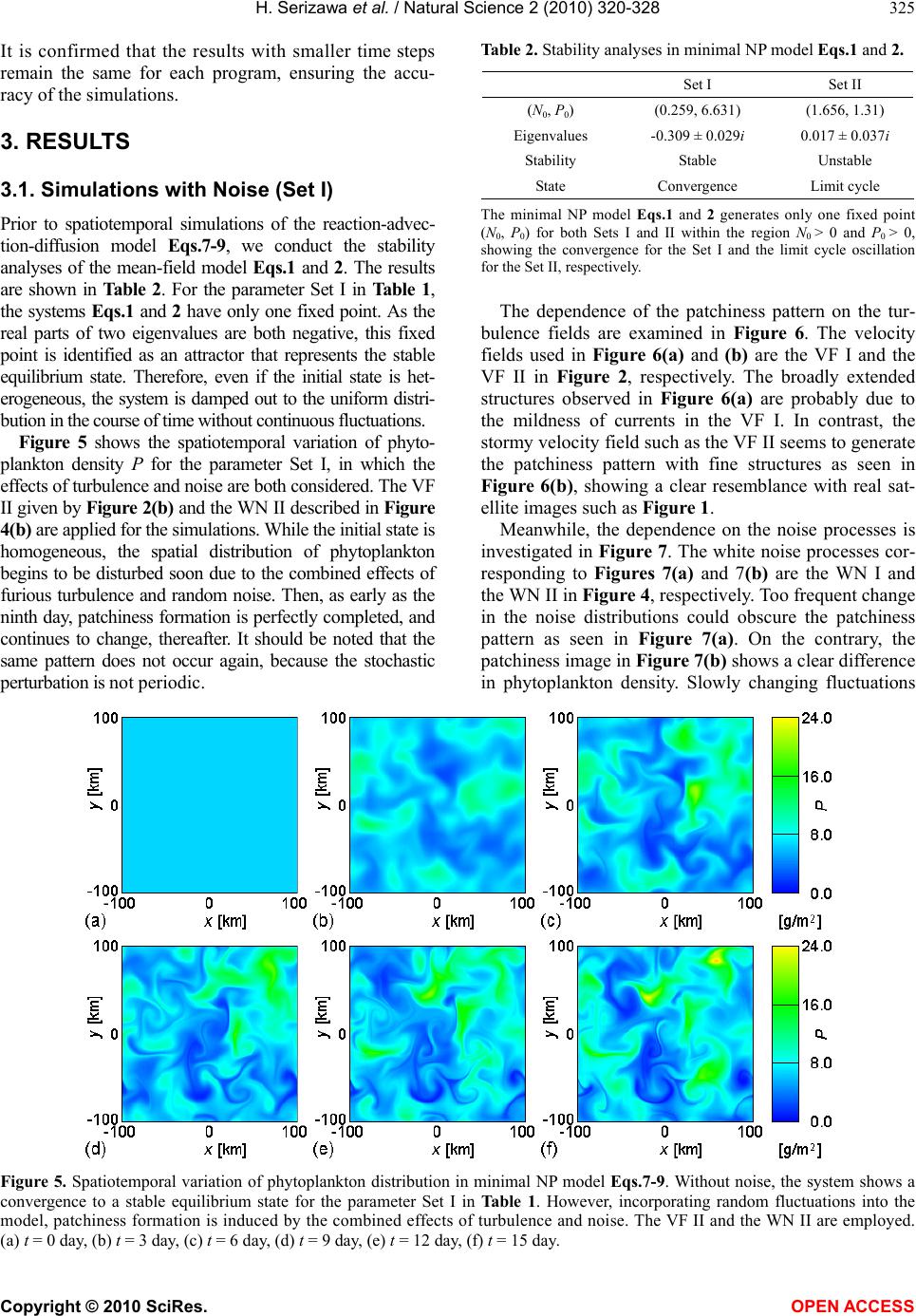 H. Serizawa et al. / Natural Science 2 (2010) 320-328 Copyright © 2010 SciRes. OPEN ACCESS 325 It is confirmed that the results with smaller time steps remain the same for each program, ensuring the accu- racy of the simulations. 3. RESULTS 3.1. Simulations with Noise (Set I) Prior to spatiotemporal simulations of the reaction-advec- tion-diffusion model Eqs.7-9, we conduct the stability analyses of the mean-field model Eqs.1 and 2. The results are shown in Table 2. For the parameter Set I in Table 1, the systems Eqs.1 and 2 have only one fixed point. As the real parts of two eigenvalues are both negative, this fixed point is identified as an attractor that represents the stable equilibrium state. Therefore, even if the initial state is het- erogeneous, the system is damped out to the uniform distri- bution in the course of time without continuous fluctuations. Figure 5 shows the spatiotemporal variation of phyto- plankton density P for the parameter Set I, in which the effects of turbulence and noise are both considered. The VF II given by Figure 2(b) and the WN II described in Figure 4(b) are applied for the simulations. While the initial state is homogeneous, the spatial distribution of phytoplankton begins to be disturbed soon due to the combined effects of furious turbulence and random noise. Then, as early as the ninth day, patchiness formation is perfectly completed, and continues to change, thereafter. It should be noted that the same pattern does not occur again, because the stochastic perturbation is not periodic. Table 2. Stability analyses in minimal NP model Eqs.1 and 2. Set I Set II (N0, P0) (0.259, 6.631) (1.656, 1.31) Eigenvalues -0.309 ± 0.029i 0.017 ± 0.037i Stability Stable Unstable State Convergence Limit cycle The minimal NP model Eqs.1 an d 2 generates only one fixed point (N0, P 0) for both Sets I and II within the region N0 > 0 and P0 > 0, showing the convergence for the Set I and the limit cycle oscillation for the Set II, respectively. The dependence of the patchiness pattern on the tur- bulence fields are examined in Figure 6. The velocity fields used in Figure 6(a) and (b) are the VF I and the VF II in Figure 2, respectively. The broadly extended structures observed in Figure 6(a) are probably due to the mildness of currents in the VF I. In contrast, the stormy velocity field such as the VF II seems to generate the patchiness pattern with fine structures as seen in Figure 6(b), showing a clear resemblance with real sat- ellite images such as Figure 1. Meanwhile, the dependence on the noise processes is investigated in Figure 7. The white noise processes cor- responding to Figures 7(a) and 7(b) are the WN I and the WN II in Figure 4, respectively. Too frequent change in the noise distributions could obscure the patchiness pattern as seen in Figure 7(a). On the contrary, the patchiness image in Figure 7(b) shows a clear difference in phytoplankton density. Slowly changing fluctuations Figure 5. Spatiotemporal variation of phytoplankton distribution in minimal NP model Eqs.7-9. Without noise, the system shows a convergence to a stable equilibrium state for the parameter Set I in Table 1. However, incorporating random fluctuations into the model, patchiness formation is induced by the combined effects of turbulence and noise. The VF II and the WN II are employed. (a) t = 0 day, (b) t = 3 day, (c) t = 6 day, (d) t = 9 day, (e) t = 12 day, (f) t = 15 day.  H. Serizawa et al. / Natural Science 2 (2010) 320-328 Copyright © 2010 SciRes. OPEN ACCESS 326 Figure 6. Dependence of phytoplankton distribution on veloc- ity field in minimal NP model Eqs.7-9. The parameters are given by the Set I, and the WN II is employed. t = 15 day. (a) VF I, (b) VF II (same as Figure 5(f)). intensify the effects of random noise, facilitating the emergence of both the densely populated and the spars- ely populated areas. 3.2. Simulations with Limit Cycle Oscillation (Set II) For the comparison, we also survey the pattern forma- tion in the oscillatory regime. According to the stability analysis for the parameter Set II, the fixed point of the system becomes unstable as shown in Table 2, and the limit cycle is formed around it. In this case, random noise is not necessary, because the continuous oscillation encourages the pattern formation unless the initial dis- tribution is homogeneous [6]. The spatiotemporal variation of phytoplankton density P for the parameter Set II is shown in Figure 8. Only the effect of turbulence is considered employing the VF II. Instead, the initial distributions of both components are not homogeneous but randomly dispersed. Patchiness patterns are formed also in this case for the almost same period as in Figure 5. However, it could be happened that the similar patterns appear repeatedly with the pe- riod of the limit cycle oscillation, which was the case in our previous study [6]. 4. DISCUSSIONS 4.1. Comparison with Field Observations Our simulation results seem to show a close similarity with satellite images such as Figure 1. Stretched and curled patterns characteristic of marine patchiness are clearly reproduced particularly in Figure 5, which em- ploys energetic turbulence as the VF II and slowly changing white noise process as the WN II. We attempt some kinds of numerical comparisons. First, the size of our simulation images are comparable to that of the satellite images in Figure 1, which covers the area of some hundreds kilometers. Considering that Figure 7. Dependence of phytoplankton distribution on white noise process in minimal NP model Eqs.7-9. The parameters are given by the Set I, and the VF II is employed. t = 15 day. (a) WN I, (b) WN II (same as Figure 5(f)). most of the patchiness images supplied by NASA are of a similar size with Figure 1, we can insist that the veloc- ity field and the noise process adopted in our method are suitable for patchiness simulations. Comparing the horizontal diffusivity to experimental data, two types of diffusion must be distinguished [6,14]. The first type of diffusion is usual diffusion originating from a tendency toward homogeneity. This type of dif- fusion is represented by the second order differential for position coordinates. Thus, the diffusion coefficient D used in the minimal NP model Eq.7-Eq.9 corresponds to this type. However, this type of diffusion does not stand for real diffusion in marine ecosystems. In the context of computer simulations, diffusion of this type merely functions as a smoothing factor that prevents divergence of the system. Meanwhile, there exists another type of diffusion origi- nating from advection by currents and eddies, which is represented by the first order differential for position coordinates. It is this type of diffusion that is responsible for patchiness formation in oceanic environments. Thus, the real diffusion coefficient must be recalculated from the velocity fields V in Figure 2. The real diffusion coefficient Dad can be evaluated by the following equation: . 2 Dad LD (10) As a rough approximation, suppose that the character- istic scale of diffusion LD is given by the average veloc- ity Vav. In the case the VF II in Figure 2(b) is LD ~3.0 km. Then, we can estimate the value of turbulent diffu- sivity Dad as about 4.5 km2/day. This value is converted to about 5 × 105 cm2/sec, which is in agreement with the empirical data estimated by Okubo [15] that range from 5 × 102 to 2 × 106 cm2/sec. 4.2. Crucial Factors for Patchiness Formation Turbulence and persistent variation of phytoplankton population are two essential factors for creating marine patchiness. Particularly as for turbulence, many re- 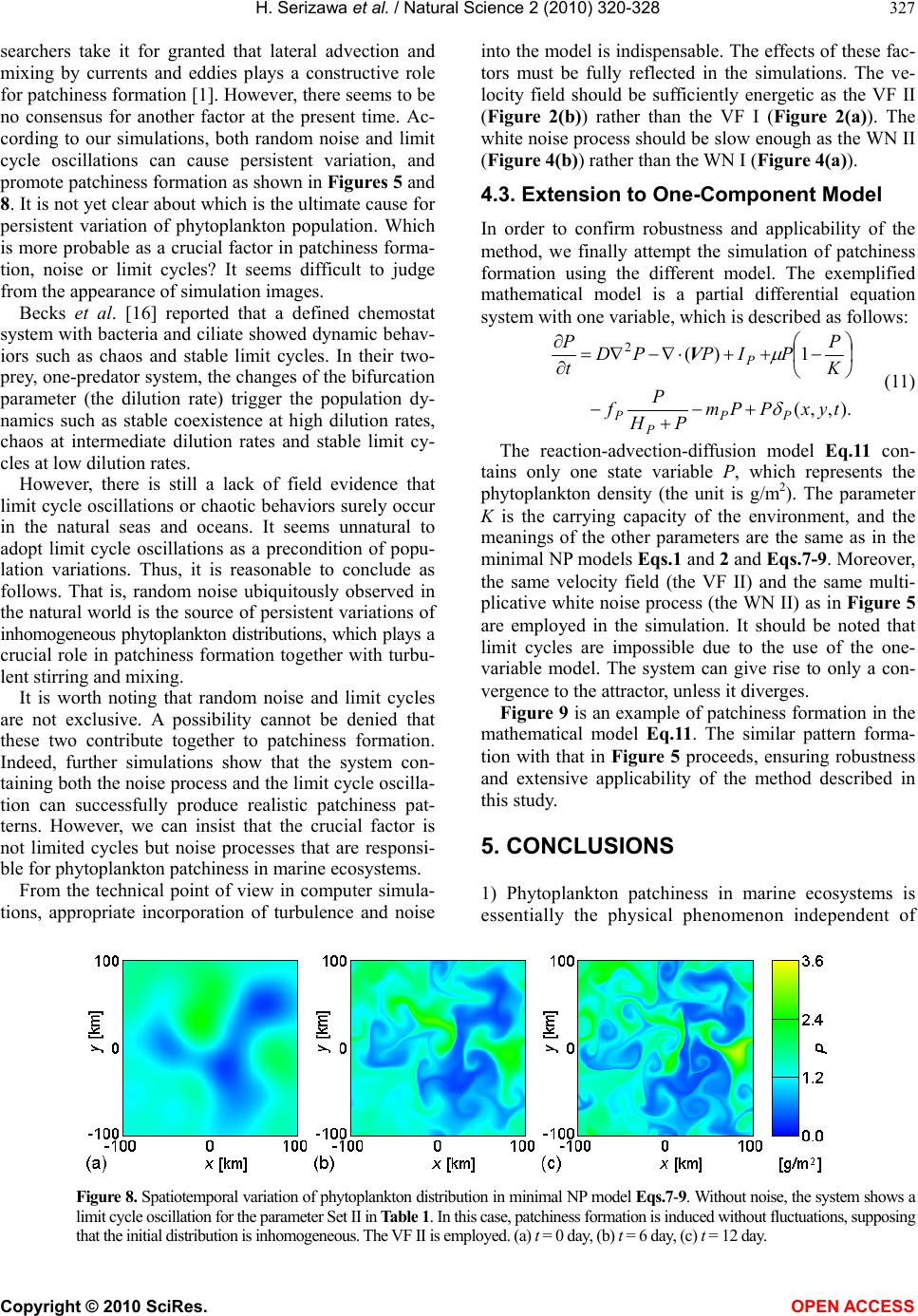 H. Serizawa et al. / Natural Science 2 (2010) 320-328 Copyright © 2010 SciRes. OPEN ACCESS 327 searchers take it for granted that lateral advection and mixing by currents and eddies plays a constructive role for patchiness formation [1]. However, there seems to be no consensus for another factor at the present time. Ac- cording to our simulations, both random noise and limit cycle oscillations can cause persistent variation, and promote patchiness formation as shown in Figures 5 and 8. It is not yet clear about which is the ultimate cause for persistent variation of phytoplankton population. Which is more probable as a crucial factor in patchiness forma- tion, noise or limit cycles? It seems difficult to judge from the appearance of simulation images. Becks et al. [16] reported that a defined chemostat system with bacteria and ciliate showed dynamic behav- iors such as chaos and stable limit cycles. In their two- prey, one-predator system, the changes of the bifurcation parameter (the dilution rate) trigger the population dy- namics such as stable coexistence at high dilution rates, chaos at intermediate dilution rates and stable limit cy- cles at low dilution rates. However, there is still a lack of field evidence that limit cycle oscillations or chaotic behaviors surely occur in the natural seas and oceans. It seems unnatural to adopt limit cycle oscillations as a precondition of popu- lation variations. Thus, it is reasonable to conclude as follows. That is, random noise ubiquitously observed in the natural world is the source of persistent variations of inhomogeneous phytoplankton distributions, which plays a crucial role in patchiness formation together with turbu- lent stirring and mixing. It is worth noting that random noise and limit cycles are not exclusive. A possibility cannot be denied that these two contribute together to patchiness formation. Indeed, further simulations show that the system con- taining both the noise process and the limit cycle oscilla- tion can successfully produce realistic patchiness pat- terns. However, we can insist that the crucial factor is not limited cycles but noise processes that are responsi- ble for phytoplankton patchiness in marine ecosystems. From the technical point of view in computer simula- tions, appropriate incorporation of turbulence and noise into the model is indispensable. The effects of these fac- tors must be fully reflected in the simulations. The ve- locity field should be sufficiently energetic as the VF II (Figure 2(b)) rather than the VF I (Figure 2(a)). The white noise process should be slow enough as the WN II (Figure 4(b)) rather than the WN I (Figure 4(a)). 4.3. Extension to One-Component Model In order to confirm robustness and applicability of the method, we finally attempt the simulation of patchiness formation using the different model. The exemplified mathematical model is a partial differential equation system with one variable, which is described as follows: ).,,( 1)( 2 tyxPPm PH P f K P PIPPD t P PP P P P V (11) The reaction-advection-diffusion model Eq.11 con- tains only one state variable P, which represents the phytoplankton density (the unit is g/m2). The parameter K is the carrying capacity of the environment, and the meanings of the other parameters are the same as in the minimal NP models Eqs.1 and 2 and Eqs.7-9. Moreover, the same velocity field (the VF II) and the same multi- plicative white noise process (the WN II) as in Figure 5 are employed in the simulation. It should be noted that limit cycles are impossible due to the use of the one- variable model. The system can give rise to only a con- vergence to the attractor, unless it diverges. Figure 9 is an example of patchiness formation in the mathematical model Eq.11. The similar pattern forma- tion with that in Figure 5 proceeds, ensuring robustness and extensive applicability of the method described in this study. 5. CONCLUSIONS 1) Phytoplankton patchiness in marine ecosystems is essentially the physical phenomenon independent of Figure 8. Spatiotemporal variation of phytoplankton distribution in minimal NP model Eqs.7-9. Without noise, the system shows a limit cycle oscillation for the parameter Set II in Table 1. In this case, patchiness formation is induced without fluctuations, supposing that the initial distribution is inhomogeneous. The VF II is employed. (a) t = 0 day, (b) t = 6 day, (c) t = 12 day.  H. Serizawa et al. / Natural Science 2 (2010) 320-328 Copyright © 2010 SciRes. OPEN ACCESS 328 Figure 9. Spatiotemporal variation of phytoplankton distribution in mathematical model Eq.11. Without noise, the sys- tem shows a convergence to a stable equilibrium state for the following parameters: IP = 0.1 g・m-2・day-1, μ = 0.5 day-1, K = 20.0 g/m2, fP = 1.6 g・m-2・day-1, HP = 2.4 g/m2, mP = 0.1 day-1. The units are altered to those of the two-dimensional model. The VF II and the WN II are employed. (a) t = 0 day, (b) t = 6 day, (c) t = 12 day. each biological process. Turbulence and noise are two major factors that promote patchiness formation in oce- anic environments. The pattern formation is guaranteed by persistent variations of the phytoplankton population. Stochastic noise is one of the most probable causes re- sponsible for continuous variations. In addition, stirring and mixing by currents and eddies facilitate the creation of stretched and curled structures characteristic of phytoplankton patchiness. 2) Patchiness formation can be simulated in the spa- tially extended reaction-advection-diffusion system that properly integrates the turbulence field and the noise process. Sufficiently furious turbulence such as the VF II (Figure 2(b)) and slowly changing fluctuations such as the WN II (Figure 4(b)) are the key to reproduce realis- tic images of patchiness. 3) The simulations of patchiness formation can be performed by whatever model with the stable equilib- rium state. Robustness in model simulations and appli- cability to various models could explain the universality of the phenomenon that is observed worldwide on Earth. 6. ACKNOWLEDGEMENTS This study is supported by the Global COE Program “Global Eco-Risk Management from Asian View Points” by the Ministry of Education, Culture, Sports, Science and Technology, Japan. REFERENCES [1] Martin, A.P. (2003) Phytoplankton patchiness: The role of lateral stirring and mixing. Progress in Oceanography, 57(2), 125-174. [2] Medvinsky, A.B., Petrovskii, S.V., Tikhonova, I.A., Malchow, H. and Li, B.-L. (2002) Spatiotemporal com- plexity of plankton and fish dynamics. SIAM Review, 44(3), 311-370. [3] Abraham, E.R. (1998) The generation of plankton patchi- ness by turbulent stirring. Nature, 391(6667), 577-580. [4] Neufeld, Z., Haynes, P.H., Garçon, V. and Sudre, J. (2002) Ocean fertilization experiments may initiate a large scale phytoplankton bloom. Geophysical Research Letters, 29(11), 1-4. [5] Tzella, A. and Haynes, P.H. (2007) Small-scale spatial structure in plankton distributions. Biogeosciences, 4(2), 173-179. [6] Serizawa, H., Amemiya, T. and Itoh, K. (2008) Patchi- ness in a minimal nutrient-phytoplankton model. Journal of Biosciences, 33(3 ), 391-403. [7] Dyke, P.P.G. and Robertson, T. (1985) The simulation of offshore turbulent dispersion using seeded eddies. Ap- plied Mathematical Modelling, 9(6), 429-433. [8] Serizawa, H., Amemiya, T. and Itoh, K. (2009) Noise- triggered regime shifts in a simple aquatic model. Eco- logical Complexity, 6(3), 375-382. [9] Vainstein, M.H., Rubí, J.M. and Vilar, J.M.G. (2007) Stochastic population dynamics in turbulent fields. The European Physical Journal-Special Topics, 146(1), 177- 187. [10] Spagnolo, B., Valenti, D. and Fiasconaro, A. (2004) Noise in ecosystems: A short review. Mathematical Biosciences and Engineering, 1(1), 185-211. [11] Provata, A., Sokolov, I.M. and Spagnolo, B. (2008) Edi- torial: Ecological complex systems. The European Physical Journal B, 65(3), 307-314. [12] Guttal, V. and Jayaprakash, C. (2007) Impact of noise on bistable ecological systems. Ecological Modelling, 201 (3-4), 420-428. [13] Spagnolo, B., Fiasconaro, A. and Valenti, D. (2003) Noise induced phenomena in Lotka-Volterra systems. Fluctuation and Noise Letters, 3(2), 177-185. [14] Serizawa, H., Amemiya, T. and Itoh, K. (2009) Patchi- ness and bistability in the comprehensive cyanobacterial model (CCM). Ecological Modelling, 220(6), 764-773. [15] Okubo, A. (1971) Oceanic diffusion diagram. Deep Sea Research and Oceanographic Abstracts, 18(8), 789-802. [16] Becks, L., Hilker, F.M., Malchow, H., Jürgens, K. and Arndt, H. (2005) Experimental demonstration of chaos in a microbial food web. Nature, 435(30), 1226-1229.
|